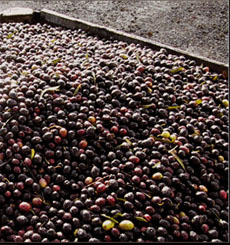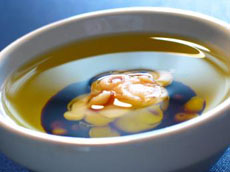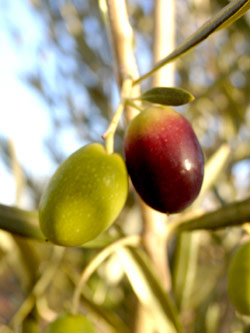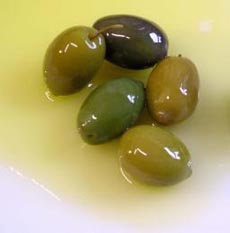Olive Oil & Olives Glossary
Page 2: Terms With C
This is Page 2 of the Olive Oil & Olives Glossary. If you think we should consider terms or definitions than those we have provided, use the Contact Us links on this page. Also read our article, Flavors and Aromas of Olive Oil. Visit our collection of 60+ food glossaries to learn more about other food products.
You can click on the letter of the alphabet in the bar below to get to a term
without having to scroll manually.
a b c d e f g h i j k l m n o p q r s t u v w x y z
This glossary is protected by copyright and cannot be reproduced in whole or part.
CERIGNOLA OLIVE
A large, fruity and buttery-tasting olive, the Cerignola is a popular olive to marinate for hors d’oeuvres. The flavors pair especially well with Sauvignon Blanc.
COLD PRESSED or COLD PRESSING or FIRST PRESSING or FIRST COLD PRESSING
IOOC Definition: “Cold pressed” is an anachronistic and largely unregulated label description for olive oil. Fifty years ago when most oil was made in vertical presses, the  paste was pressed to make olive oil (see first press) and then mixed with hot water or steam and pressed again to remove more oil. This “second pressing” was not as good; the heat had evaporated some of the delicate flavors. Today the paste is almost always warmed to room temperature during the malaxation process (no heat is used above about 60°F) before being centrifuged using horizontal decanters (olives are harvested in the winter when it is cold). According to IOOC regulations this is still considered “cold pressed.” Heating the paste excessively increases yield but degrades flavor. Producers would lose money by attempting to extract a little more oil by overheating and degrading the flavor of the oil to the point where it would not qualify as more profitable extra virgin. After the oil is pressed out of the paste, the dry pomace (pits and flesh) is sometimes sold to refineries where steam and solvents are used to remove any residual oil. This oil is called pomace olive oil. paste was pressed to make olive oil (see first press) and then mixed with hot water or steam and pressed again to remove more oil. This “second pressing” was not as good; the heat had evaporated some of the delicate flavors. Today the paste is almost always warmed to room temperature during the malaxation process (no heat is used above about 60°F) before being centrifuged using horizontal decanters (olives are harvested in the winter when it is cold). According to IOOC regulations this is still considered “cold pressed.” Heating the paste excessively increases yield but degrades flavor. Producers would lose money by attempting to extract a little more oil by overheating and degrading the flavor of the oil to the point where it would not qualify as more profitable extra virgin. After the oil is pressed out of the paste, the dry pomace (pits and flesh) is sometimes sold to refineries where steam and solvents are used to remove any residual oil. This oil is called pomace olive oil.
Photo: Harvested olives waiting to be pressed at O Olive Oil.
COLOR
Color is an indicator of olive oil freshness, but not necessarily an absolute indicator: Smell and  taste should be the guide. There are many different varieties of olives, and different cultivars produce different colors of oil. Some types of olives will produce an oil that is more golden, some are quite green. The color also depends on the ripeness of the olives at the time of harvest. Very ripe olives will produce oil that is more yellow than green olives. This is neither good or bad, but a matter of preference. taste should be the guide. There are many different varieties of olives, and different cultivars produce different colors of oil. Some types of olives will produce an oil that is more golden, some are quite green. The color also depends on the ripeness of the olives at the time of harvest. Very ripe olives will produce oil that is more yellow than green olives. This is neither good or bad, but a matter of preference.
Photo by Daniel West | SXC.
CONDIMENT OIL
See anointing oil.
COOC
 The California Olive Oil Council, the regulating body that establishes standards for member producers that make olive oil in California. The California Olive Oil Council, the regulating body that establishes standards for member producers that make olive oil in California.
CORATINA OLIVE
The Coratina olive is cultivated largely in southern Italy, in the provinces of Apulia and Baria. Grown as both a table olive and an oil olive, it has a high level of fruitiness, the aroma of green leaf and hints of apple. It has characteristic bitterness and pungency, plus astringency with a slightly noticeable sweetness. The oil has a high degree of stability.
Coratina olive trees are available from
Olive-Trees.net.
CORNICABRA OLIVE
One of the main Spanish olives, grown in the La Mancha region of central Spain (Castille), near Toledo. It produces a rustic oil—a medium to high olive fruity flavor and a strong aroma—bringing to mind the flavorful nuances of fresh, ripe fruit. pungent and green flavor. Cornicabra oils are very smooth on the palate and can have a slight almond finish. The oil is very stable, i.e., retains its freshness and does not turn rancid for a longer period than most other olive oils.
CRACKED OLIVE or SLIT OLIVE or SPLIT OLIVE
Cracked olives have been split open to allow better marinating with olive oil, vinegar, herbs and spices. This process is typically reserved for green olives.
CULTIVAR
A variety of a plant that has been created or selected intentionally and maintained through cultivation. From the five subspecies of olive free, there are thousands of cultivars of the olive. In Italy alone at least three hundred cultivars have been enumerated, but only a few are grown to a large extent.
CURING
Olives are unpalatable until they are cured. They can be brine-cured, dry-cured, lye-cured, oil-cured or water-cured. Green olives must be soaked in a lye solution (sodium hydroxide) prior to brining and then washed thoroughly in water to remove oleuropein, a naturally bitter carbohydrate (a glycoside) in the fruit. Ripe, black olives can proceed straight to brining. Green olives are fermented before being packed in a brine solution. American black olives are not fermented, which is why they have a milder flavor than either green olives or imported black olives.
Continue To Next Page: Terms With D & E
Go To The Article Index Above
Lifestyle Direct, Inc. All rights reserved. Images are the copyright of their individual owners.

|





 paste was pressed to make olive oil (see
paste was pressed to make olive oil (see  taste should be the guide. There are many different varieties of olives, and different cultivars produce different colors of oil. Some types of olives will produce an oil that is more golden, some are quite green. The color also depends on the ripeness of the olives at the time of harvest. Very ripe olives will produce oil that is more yellow than green olives. This is neither good or bad, but a matter of preference.
taste should be the guide. There are many different varieties of olives, and different cultivars produce different colors of oil. Some types of olives will produce an oil that is more golden, some are quite green. The color also depends on the ripeness of the olives at the time of harvest. Very ripe olives will produce oil that is more yellow than green olives. This is neither good or bad, but a matter of preference.  The California Olive Oil Council, the regulating body that establishes standards for member producers that make olive oil in California.
The California Olive Oil Council, the regulating body that establishes standards for member producers that make olive oil in California.